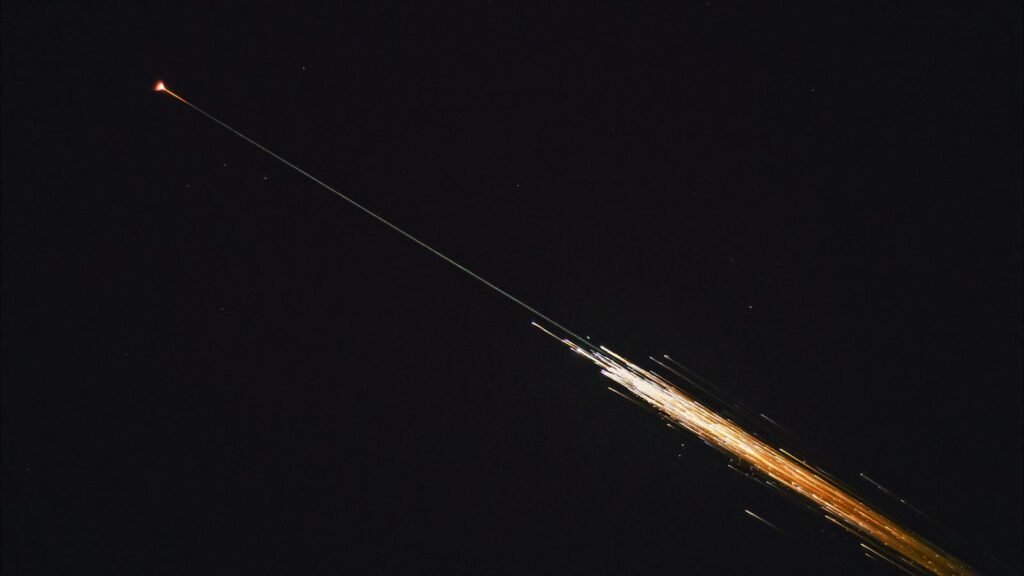This week’s edition of The Prototype explores the question of whether we should be concerned about spaceborne bacteria, a clinical trial for nerve regeneration after a traumatic injury, a new class of electronics, and more. Sign up to receive The Prototype in your inbox here.
A Chinese spacecraft returning from the Tiangong space station
VCG via Getty Images
A previously unknown strain of bacteria has been discovered on China’s Tiangong space station, as revealed in a recent study. These new microorganisms were found on swabs taken from the station, prompting comparisons to the novel (and movie) The Andromeda Strain, a story about a disease from space reaching Earth via a government satellite.
Despite this discovery, Amesh Adalja, a senior scholar at the Johns Hopkins Center for Health Security, assures that spaceborne microorganisms are unlikely to cause a new pandemic. He emphasizes that the majority of bacterial organisms pose no harm. Adalja explains that while these microbes may thrive in extreme environments, their ability to adapt does not necessarily mean they would thrive in a different environment. Evaluating the potential disease risk of such organisms involves assessing their ability to survive in human bodies and whether they cause harm. Adalja notes that most bacteria residing on or in humans are not harmful.
Even if a new microorganism from space were to cause a disease, Adalja affirms that researchers have the tools to study its characteristics, such as DNA, to develop treatments or vaccines.
Stay tuned for updates.
Clinical Trials Begin For Nerve Regeneration Device
Auxilium Biotechnologies
Each year, over 300,000 individuals suffer from accidents resulting in damage to their peripheral nerves, which can lead to disability. Current treatments often involve surgically grafting healthy nerve tissue from one part of the body to the damaged area, a procedure that can have complications and side effects. Auxilium Biotechnologies, based in San Diego, has developed a device called the NeuroSpan Bridge to aid in nerve regeneration. This device guides damaged nerves to grow in a specific direction, facilitating repair without the need for grafting.
The company has announced the commencement of a clinical trial involving 80 patients with nerve trauma using this innovative device. CEO and cofounder Jacob Koffler, a neuroscience professor at UC San Diego, explains that while nerves can regenerate naturally, they may not always reconnect with healthy nerves. The NeuroSpan Bridge aims to organize nerve regeneration by directing the growth of regenerated nerves towards healthy tissue. Successful results in mice have paved the way for human trials, with potential FDA approval for commercialization following positive outcomes.
DISCOVERY OF THE WEEK: A NEW CLASS OF MATERIALS
Researchers at Rutgers University have developed “intercrystals,” a new substance with the potential to revolutionize future electronics. Comprising two layers of graphene and a crystal made from boron and nitrogen, this material enhances electron transmission efficiency at the atomic level. The discovery holds promise for more efficient electronic components like sensors and transistors, with the added benefit of utilizing abundant and sustainable elements such as carbon, boron, and nitrogen.
FINAL FRONTIER: LESS RESEARCH AHEAD FOR THE INTERNATIONAL SPACE STATION
NASA is facing budget constraints that may necessitate reductions in crew size and scientific research aboard the International Space Station. Considerations include operating the U.S. portion with a three-person crew instead of four and fewer planned cargo flights, impacting revenue for contractors like SpaceX and Northrop Grumman. The future of private missions to the ISS, such as those by Axiom Space utilizing SpaceX, remains uncertain.
WHAT ELSE I WROTE THIS WEEK
I explored Abel Avellan’s AST SpaceMobile, a company competing with SpaceX and Jeff Bezos’ Project Kuiper to provide broadband satellite internet directly to smartphones. This innovation aims to connect remote areas and bridge the gap for the 2.6 billion people lacking regular internet access.
In my other newsletter, InnovationRx, Amy Feldman and I delved into the FDA’s new COVID-19 vaccine regulations, Novartis’s acquisition strategy, Medtronic’s diabetes spinoff, Regeneron’s acquisition of 23AndMe, and more.
SCIENCE AND TECH TIDBITS
Recycling electronics may become more efficient thanks to researchers at the University of Helsinki who have found a way to extract silver from old electronics using used cooking oil.
Funding for scientific research hits a 35-year low, as reported by the New York Times, affecting various fields due to reduced grants from the National Science Foundation.
Energy infrastructure projects often exceed budgets and timelines, according to a recent study. Nuclear power plants face the highest risks, while solar power projects tend to finish ahead of schedule or under budget.
Researchers have developed a new lithium battery that captures carbon dioxide from the atmosphere. Unlike previous attempts, this new iteration offers a cost-effective and scalable solution, ideal for applications on Mars where carbon dioxide is abundant.
PRO SCIENCE TIP: WANT TO LOSE WEIGHT? EAT DESSERT
Restrictive diets for weight loss can lead to cravings and binge eating. A recent study suggests incorporating favorite foods, including junk food, into balanced meals can aid in weight loss and reduce cravings.
WHAT’S ENTERTAINING ME THIS WEEK
In the era of streaming, catching up on missed shows has become a delight. Currently, I’m immersed in Boardwalk Empire, a captivating series depicting organized crime and corruption during Prohibition in Atlantic City. Steve Buscemi shines in the lead role, making it a must-watch for fans of mob dramas. All episodes are available for streaming on HBO Max.
MORE FROM FORBES


